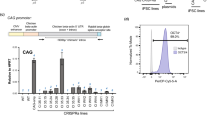Abstract
Oct4 is a POU domain homeobox gene, expressed in undifferentiated embryonal carcinoma and embryonic stem cells and is quickly down-regulated upon induction of differentiation. Transcriptional repression of Oct4 is followed by pronounced epigenetic changes on the regulatory region of the gene. Oct4 has a long upstream regulatory region of about 2,600 bp, consisting of proximal enhancer (PE), distal enhancer (DE), and proximal promoter (PP). In this study, we induced differentiation of a human embryonic carcinoma cell line, NT2, under two different adherent and non-adherent culture conditions, and compared histone modifications as the epigenetic marks on the regulatory region of Oct4 gene after 3 days of differentiation. Using chromatin immunoprecipitation coupled with real-time PCR technique, it was shown that the after induction of differentiation the repressive epigenetic marks of hypoacetylation and methylation on lysine-9 of histone H3 occurred very effectively on the upstream of Oct4, especially in PP region. Also, comparing the two culturing systems it was shown that methylation of lysine-9 of H3 histone was more drastic in PE region of adherent cells rather than suspension cells. This epigenetic profile was in agreement with the difference observed in the expression level of Oct4 in these two culturing systems. The current study clearly shows the effective role of cell culture condition on the epigenetic regulation of gene expression.


Similar content being viewed by others
References
Nichols J, Zevnik B, Anastassiadis K, Niwa H, Klewe-Nebenius D, Chambers I, Scholer H, Smith A (1998) Formation of pluripotent stem cells in the mammalian embryo depends on the POU transcription factor Oct4. Cell 95:379–391
Pan GJ, Chang ZY, Schöler HR, Pei D (2002) Stem cell pluripotency and transcription factor Oct4. Cell Res 12:321–329
Shi G, Jin Y (2010) Role of Oct4 in maintaining and regaining stem cell pluripotency. Stem Cell Res Ther 1:39
Schöler HR, Ruppert S, Suzuki N, Chowdhury K, Gruss P (1990) New type of POU domain in germ line-specific protein Oct-4. Nature 344:435–439
Phillips K, Luisi B (2000) The virtuoso of versatility: POU proteins that flex to fit. J Mol Biol 302:1023–1039
Yeom Y, Fuhrmann G, Ovitt C, Brehm A, Ohbo K, Gross M, Hubner K, Scholer H (1996) Germline regulatory element of Oct4 specific for the totipotent cycle of embryonal cells. Integrated Ann Indexes 122:881–894
Nordhoff V, Hubner K, Bauer A, Orlova I, Malapetsa A, Scholer HR (2001) Comparative analysis of human, bovine, and murine Oct4 upstream promoter sequences. Mamm Genome 12:309–317
Ovitt CE, Scholer HR (1998) The molecular biology of Oct-4 in the early mouse embryo. Mol Human Reprod 4:1021–1031
Okazawa H, Okamoto K, Ishino F, Ishino-Kaneko T, Takeda S, Toyoda Y, Muramatsu M, Hamada H (1991) The oct3 gene, a gene for an embryonic transcription factor, is controlled by a retinoic acid repressible enhancer. EMBO J 10:2997–3005
Schoorlemmer J, van PA, van Den Eijnden M, Jonk L, Pals C, Kruijer W (1994) Characterization of a negative retinoic acid response element in the murine Oct4 promoter. Mol Cell Biol 14:1122–1136
Ben-Shushan E, Pikarsky F, Klar A, Bergman Y (1993) Extinction of Oct-3/4 gene expression in embryonal carcinoma* fibroblast somatic cell hybrids is accompanied by changes in the methylation status, chromatin structure, and transcriptional activity of the Oct-3/4 upstream region. Mol Cell Biol 13:891–901
Ben-Shushan E, Sharir H, Pikarsky F, Bergman Y (1995) A dynamic balance between ARP-1/COUP-TFII, EAR-3/Coup-TFI, and retinoic acid receptor: retinoid X receptor hetero dimers regulates Oct3/4 expression in embryonal carcinoma cells. Mol Cell Biol 15:1034–1048
Shahoseini M, Taei A, Mehrjardi NZ, Salekdeh GH, Baharvand H (2010) Epigenetic analysis of human embryonic cells during RA-induced neural differentiation. Biochem Cell Biol 88:527–538
Feldman N, Gerson A, Fang J, Li E, Zhang Y, Shinkai Y, Cedar H, Bergman Y (2006) G9a-mediated irreversible epigenetic inactivation of Oct-3/4 during early embryogenesis. Nat Cell Biol 8:188–194
Kellner S, Kikyo N (2010) Transcriptional regulation of the Oct4 gene, a master gene of pluripotency. Histol Histopathol 25:405–412
Hake SB, Garcia BA, Duncan EM, Kauer M, Dellaire G, Shabanowitz J, Bazett-Jones DP, Allis CD, Hunt DF (2006) Expression patterns and post-translational modifications associated with mammalian histone H3 variants. J Biol Chem 281:559–568
Shahhoseini M, Favaedi R, Baharvand H, Sharma V, Stunnenberg HG (2010) Evidence for a dynamic role of the linker histone variant H1x during retinoic acid-induced differentiation of NT2 cells. FEBS Lett 584:4661–4664
Livak KJ, Schmittgen TD (2001) Analysis of relative gene expression data using real-time quantitative PCR and the 2-∆∆Ct method. Methods 25:402–408
Dahl JA, Collas P (2007) Q2ChIP, a quick and quantitative chromatin immunoprecipitation assay, unravels epigenetic dynamics of developmentally regulated genes in human carcinoma cells. Stem Cells 25:1037–1046
Przyborski SA, Christie VB, Hayman MW, Stewart R, Horrocks GM (2004) Human embryonal carcinoma stem cells: models of embryonic development in humans. Stem Cells Dev 13:400–408
Przyborski SA, Smith S, Wood A (2003) Transcriptional profiling of neuronal differentiation by human embryonal carcinoma stem cells in vitro. Stem Cells 21:459–471
Deb-Rinker P, Ly D, Jezierski A, Sikorska M, Walker PR (2005) Sequential DNA methylation of the Nanog and Oct-4 upstream regions in human NT2 cells during neuronal differentiation. J Biol Chem 280:6257–6260
Horrocks GM, Lauder L, Stewart R, Przyborski SA (2003) Formation of neurospheres from human embryonal carcinoma stem cells. Biochem Biophys Res Commun 304:411–416
Megiorni F, Mora B, Indovina P, Mazzilli MC (2005) Expression of neuronal markers during NTera2/cloneD1 differentiation by cell aggregation method. Neurosci Lett 373:105–110
Acknowledgment
The authors would like to dedicate this article to the memory of Dr. Saeid Kazemi Ashtiani, the late founder of Royan Institute. This project was financially supported by the Grant # 169 of Royan Institute.
Author information
Authors and Affiliations
Corresponding author
Rights and permissions
About this article
Cite this article
Favaedi, R., Shahhoseini, M. & Akhoond, M.R. Comparative epigenetic analysis of Oct4 regulatory region in RA-induced differentiated NT2 cells under adherent and non-adherent culture conditions. Mol Cell Biochem 363, 129–134 (2012). https://doi.org/10.1007/s11010-011-1165-y
Received:
Accepted:
Published:
Issue Date:
DOI: https://doi.org/10.1007/s11010-011-1165-y




